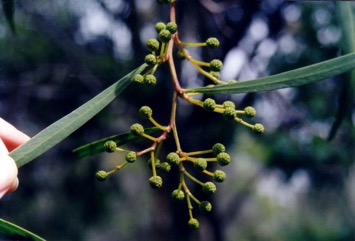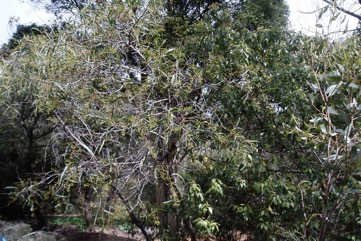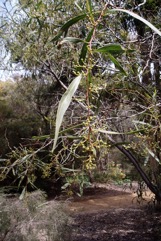Golden wreath wattle

It is a subtropical plant. It occurs in coastal areas of Western Australia. It will grow on calcareous or sandy soils. It prefers light to medium soils. It requires an open sunny position. It is drought resistant and frost tolerant. It can stand some salting. It grows well in subtropical regions. It grows in areas with an annual rainfall between 125-1,200 m above sea level. It grows below 300 m above sea level. It is wind resistant. It can grow in arid places. It suits hardiness zones 9-11. Wittunga Botanical Gardens.
Also known as:
Blue-leaf wattle, Goudwilger, Keo lieu, Orange Wattle, Port Jackson wattle, Weeping wattle
Synonyms
- Acacia cyanophylla Lindl.
- Mimosa saligna Labill.
- Racosperma saligna (Labill.) Pedley
Edible Portion
- Seeds, Gum
Where does Golden wreath wattle grow?
Found in: Africa, Algeria, Argentina, Asia, Australia, Cyprus, East Africa, Egypt, Ethiopia, Europe, France, Greece, India, Indochina, Iran, Iraq, Israel, Italy, Jordan, Kenya, Libya, Mauritius, Mediterranean, Mexico, Morocco, Mozambique, Namibia, New Zealand, North Africa, North America, Pakistan, Portugal, Saudi Arabia, SE Asia, South Africa, Southern Africa, South America, Spain, St Helena, Syria, Tanzania, Tunisia, Uganda, Uruguay, United States, Vietnam, Zambia, Zimbabwe
Notes: There are about 1,350 Acacia species. Over 1,000 occur in Australia. It has become a weed in South Africa. Also as Mimosaceae.
Growing Golden wreath wattle
Cultivation: It is grown from seed. The seed need treatment to break the hard seed coat. Normally this is by putting the seeds in very hot water and letting the water cool down overnight then planting the seeds immediately. It can be grown from cuttings. Trees re-sprout from the base when cut down.
Edible Uses: The seeds are eaten. They are crushed to flour.
Production: It is usually fast growing.
Nutrition Info
per 100g edible portion| Edible Part | Energy (kcal) | Protein (g) | Iron (mg) | Vitamin A (ug) | Vitamin c (mg) | Zinc (mg) | % Water |
|---|---|---|---|---|---|---|---|
| Seed | - | - | - | - | - | - |
Golden wreath wattle Photos



References
Asfaw, Z. and Tadesse, M., 2001, Prospects for Sustainable Use and Development of Wild Food Plants in Ethiopia. Economic Botany, Vol. 55, No. 1, pp. 47-62
Barwick, M., 2004, Tropical and Subtropical Trees. A Worldwide Encyclopedic Guide. Thames and Hudson p 4
Bekele-Tesemma A., Birnie, A., & Tengnas, B., 1993, Useful Trees and Shrubs for Ethiopia. Regional Soil Conservation Unit. Technical Handbook No 5. p 60
Bindon, P., 1996, Useful Bush Plants. Western Australian Museum. p 27
Bodkin, F., 1991, Encyclopedia Botanica. Cornstalk publishing, p 32
Bonney, N., 1997, Economic Native Trees and Shrubs for South Australia. Greening Australia (SA) inc. Campbelltown SA 5074 p 20
Comm. Acac. aphyll. 26. 1820
Cundall, P., (ed.), 2004, Gardening Australia: flora: the gardener's bible. ABC Books. p 79
Doran, J.C., & Turnbull, J.W. (Eds), 1997, Australian Trees and Shrubs: species for land rehabilitation and farm plantings in the tropics. ACIAR Monograph No 24. p 210
Elliot, W.R., & Jones, D.L., 1982, Encyclopedia of Australian Plants suitable for cultivation. Vol 2. Lothian. p 110
Etherington, K., & Imwold, D., (Eds), 2001, Botanica's Trees & Shrubs. The illustrated A-Z of over 8500 trees and shrubs. Random House, Australia. p 56
Flora of Pakistan. www.eFloras.org
Greig, D., 1996, Flowering Natives for Home Gardens. Angus & Robertson. p 39
Hall, N. et al, 1972, The Use of Trees and Shrubs in the Dry Country of Australia, AGPS, Canberra. p 195
Hnatiuk, R. J. 1990. Census of Australian vascular plants. Australian Flora and Fauna Series No. 11.
Holliday, I., 1989, A Field Guide to Australian Trees. Hamlyn. p 32
ILDIS Legumes of the World http:www;ildis.org/Legume/Web
Lazarides, M. & Hince, B., 1993, Handbook of Economic Plants of Australia, CSIRO. p 6
Lord, E.E., & Willis, J.H., 1999, Shrubs and Trees for Australian gardens. Lothian. p 42
Marchant, N. G. et al. 1987. Flora of the Perth Region.
Mbuya, L.P., Msanga, H.P., Ruffo, C.K., Birnie, A & Tengnas, B., 1994, Useful Trees and Shrubs for Tanzania. Regional Soil Conservation Unit. Technical Handbook No 6. p 64
National Academy of Sciences. 1980. Firewood crops. Shrub and tree species for energy production.
National Academy of Sciences. 1979. Tropical legumes: resources for the future
Paczkowska, G . & Chapman, A.R., 2000, The Western Australian Flora. A Descriptive Catalogue. Western Australian Herbarium. p 322
Palgrave, K.C., 1996, Trees of Southern Africa. Struik Publishers. p 250
Pham-Hoang Ho, 1999, An Illustrated Flora of Vietnam. Nha Xuat Ban Tre. p 821
Plants and People in Mooro Country. Nyungar Plant use in Yellagonga Regional Park
Plowes, N. J. & Taylor, F. W., 1997, The Processing of Indigenous Fruits and other Wildfoods of Southern Africa. in Smartt, L. & Haq. (Eds) Domestication, Production and Utilization of New Crops. ICUC p 184
Royal Botanic Gardens, Kew (1999). Survey of Economic Plants for Arid and Semi-Arid Lands (SEPASAL) database. Published on the Internet; http://www.rbgkew.org.uk/ceb/sepasal/internet [Accessed 27th April 2011]
van Wyk, B, van Wyk, P, and van Wyk B., 2000, Photographic guide to Trees of Southern Africa. Briza. p 41
Willis, J. H. 1970-1972. A handbook to plants in Victoria.
World Checklist of Useful Plant Species 2020. Royal Botanic Gardens, Kew